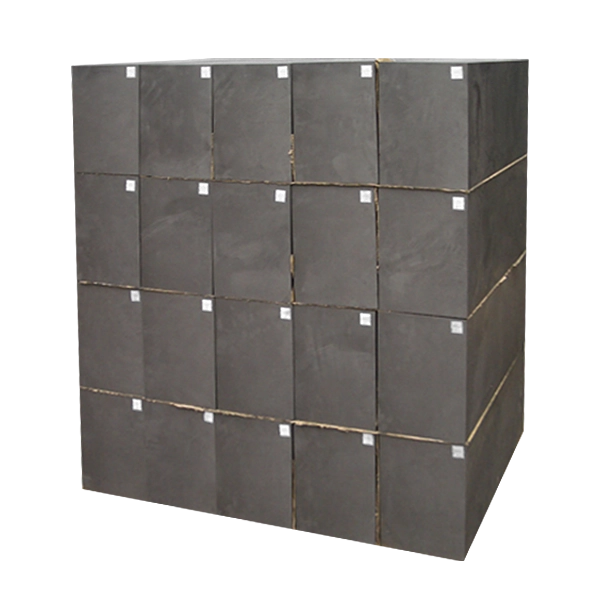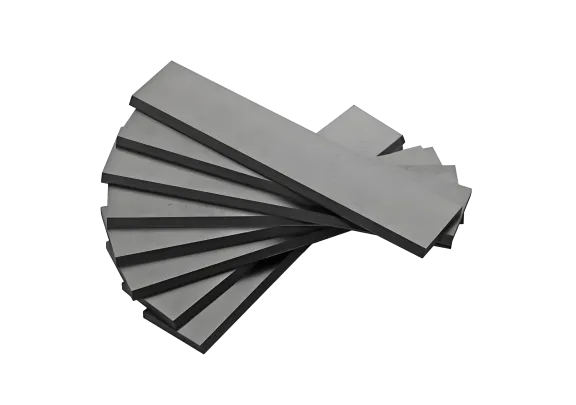
Easily Machinable: Can be precisely shaped using conventional machining techniques like milling, drilling, and turning.
Corrosion Resistance: Highly resistant to most acids, alkalis, and solvents, but reacts with oxygen at high temperatures.
Oxidation Sensitivity: Begins to oxidize around 400-600°C in air. Protective coatings or inert atmospheres are required for high-temperature applications.
Good Electrical Conductivity: Ranges from 104 to 106 S/m, making it useful for electrodes and electrical applications.
Low Electrical Resistance: Ensures efficient current transfer.
High Thermal Conductivity: Values range from 20 to 150 W/m·K, depending on the grade.
High Thermal Stability: Can withstand extreme temperatures up to 3000°C in inert atmospheres.
Low Thermal Expansion: Coefficient of thermal expansion (CTE) is typically (2–5) × 10⁻⁶ /°C, ensuring dimensional stability under heat.
High Strength: Molded graphite has good mechanical strength, though lower than metals.
Flexural Strength: Typically 10-40 MPa, depending on grain size and orientation.
Hardness: Ranges from 30 to 60 Shore D, making it relatively soft compared to metals but hard enough for machining.
Good Wear Resistance: Often used in seals, bearings, and sliding parts.
High Purity: Molded graphite can be manufactured with very low levels of impurities, making it suitable for sensitive applications.
Density: Typically ranges from 1.6 to 1.9 g/cm³, depending on the manufacturing process.
Porosity: Contains a fine-grained microstructure, resulting in controlled porosity.
Characteristics: high density, fine particles, high purity, high strength, low resistivity, suitable for fine processing. Excellent thermal shock resistance, high temperature resistance, oxidation resistance, corrosion resistance.
Applications:
Nuclear energy field: High-purity graphite is used as a neutron decelerator in nuclear reactors, which can effectively reduce the speed of neutrons and thus maintain the chain reaction. In addition, it is used in the manufacture of control rods for nuclear reactors to regulate the reaction rate of the reactor.
Aerospace industry: Due to its light weight, high strength, high thermal conductivity and good thermal shock resistance, high purity graphite is widely used in key components such as nozzles and throat linings of rocket engines as well as thermal protection systems of spacecraft.
Electronic industry: High-purity graphite is mainly used in the electronic industry to manufacture graphite electrodes, graphite anodes, graphite cathodes and other electronic devices such as encapsulation and support materials. Meanwhile, it is also an important choice of substrate material for wafer processing in semiconductor industry.
Metallurgical industry: As an advanced refractory material, high purity graphite is used to manufacture refractory materials such as blast furnace linings, electric furnace linings, crucibles, etc. Its high temperature and corrosion-resistant properties make it an indispensable material in the metallurgical industry.
Chemical industry: High-purity graphite is used as corrosion-resistant and high temperature-resistant graphite equipments and pipelines in chemical industry, such as graphite heat exchanger, graphite reactor, etc. These equipments are able to withstand high temperature, high pressure and corrosive medium erosion.
New energy field: with the development of new energy industry, high purity graphite plays an important role in lithium-ion batteries, and is an important material in semiconductor, aerospace and other fields 12. In addition, in the solar photovoltaic industry, high purity graphite also has a wide range of applications.
In addition, high purity graphite is widely used in the solar photovoltaic industry. In addition, high-purity graphite is also widely used in carbon brushes in the electrical industry, electrodes in the battery industry, catalyst additives in the fertilizer industry and other fields.
The main products of high purity graphite are: gold melting crucibles, analytical crucibles, sintering molds, heaters, vacuum furnace fittings, continuous casting molds, EDM casting molds, diamond sintering molds and so on.
Physical and chemical performance indicators:
| Physical and chemical performance indicators |
KBG-4 |
KBG-5 |
| Density g/cm³ | ≥1.8 |
≥1.85 |
| Ash content (ppm) | ≤500 | ≤500 |
| Shore hardness |
≥40 |
≥45 |
| Resistivity μΩ-m | ≤12 |
≤10 |
| Flexural strength Mpa | ≥35 |
≥40 |
|
Compressive strength Mpa |
≥60 |
≥70 |
|
Maximum particle size μm |
≤43 |
≤43 |
| Thermal expansion coefficient Mm/℃ | ≤4.5*10-6 |
≤4.4*10-6 |
Note:
1. All grades of ash can be purified to 50PPM according to customer requirements
2. If there are special requirements for indicators, special production can also be arranged.
| Rod | Diameter | Length |
| Size Range | 0-500(mm) | 0-600(mm) |
| Standard Size | 110-500(mm) | 180-600(mm) |
| Block | Length | Width |
Height |
| Size Range | 0-900(mm) | 0-400(mm) | 0-300(mm) |
|
Standard Size |
200-900(mm) | 125-400(mm) | 50-300(mm) |
Attention:
1. The above data is for reference, if there is any error, the actual measured data shall prevail
2. Larger sizes can be specially pressed, smaller ones can be further processed, and the processed parts can be made with anti-oxidation and anti-corrosion coatings according to the drawings. (Antioxidant coating or silicon carbide coating)

Molded graphite materials are synthetic graphite products formed by compressing fine graphite powder with binders and then heat-treating them at high temperatures. These materials exhibit high strength, thermal resistance, and electrical conductivity.
High thermal and electrical conductivity Excellent chemical resistance High-temperature resistance Good machinability Low coefficient of thermal expansion High strength and density
The manufacturing process generally involves the following steps: Mixing graphite powder with binders (e.g., resins or pitch) Molding under high pressure Baking at elevated temperatures Additional graphitization at extremely high temperatures (typically above 2500°C)
Molded graphite is widely used in: Electrical Discharge Machining (EDM) Semiconductor and solar industries High-temperature furnaces Seals and gaskets Lubrication components Electrodes for various industrial processes
Molded Graphite: Manufactured using conventional pressing techniques, leading to slightly lower density and mechanical strength. Isostatic Graphite: Produced using isostatic pressing, which results in uniform density, finer grain size, and superior mechanical properties.
Yes, molded graphite is easily machinable due to its relatively soft and uniform structure. It can be cut, drilled, and shaped into intricate designs for industrial applications.
Molded graphite exhibits excellent thermal stability and can withstand temperatures above 3000°C in non-oxidizing atmospheres. However, it oxidizes at high temperatures in the presence of oxygen.
Yes, molded graphite is highly resistant to acids, alkalis, and most solvents, making it ideal for use in harsh chemical environments.
The density of molded graphite depends on the particle size of the raw graphite powder and the molding pressure. Higher molding pressure results in higher density and strength.
Yes, molded graphite has high electrical conductivity, making it suitable for applications such as electrodes, electrical contacts, and battery components.